|
|
ARTHROPODS:
Insects»
Spiders»
Centipedes»
Millipedes»
Sowbugs»
Harvestmen»
Mites
& Ticks»
Scorpions»
Identification
Tips»
About
the Critter Files»
Links» |
|
|
|
 |
STINK
BUGS
Critter
Files/Insects/True
Bugs/Stink Bugs
By Blake Newton
University of Kentucky Department of Entomology |
| |
|
| Common
Kentucky Stink Bugs: |
| |
| TAXONOMY |
KINGDOM:
Animalia | PHYLUM: Arthropoda | CLASS: Insecta | ORDER: Hemiptera
| FAMILY: Pentatomidae (stink bugs) |
| |
| Other
Names: Pentatomids |
| |
WHAT
IS A STINK BUG?
LIFE CYCLE
ECOLOGY
PEST STATUS
COMMON KENTUCKY STINK BUGS
COLLECTING & PHOTOGRAPHY
STINK BUG FACTS
MYTHS, LEGENDS, AND FOLKLORE |
| |
| WHAT
IS A STINK BUG? |
|
Stink Bugs
are in the order Hemiptera which also includes assassin
bugs, plant bugs, and many other insects. All insects
in Hemiptera share a few characteristics, including piercing and
sucking mouthparts, and wings which are membranous and clear at
the tips, but hardened at the base.
Stink Bugs, sometimes
called "pentatomids" (from the family name Pentatomidae,
which means "5-sided") are distinguished from other members
of Hemiptera by their broad, shield-shaped bodies, 5-segmented antennae,
and large "scutellums". The scutellum is a triangular-shaped
part of the thorax. Although it is present on all insects,
it extends halfway down the backs of stink bugs and is very noticeable.
The scutellum is outlined in blue in the picture below: |
| |
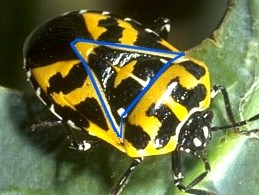 Harlequin
Bug, showing scutellum (R. Bessin, 2000)
Harlequin
Bug, showing scutellum (R. Bessin, 2000) |
| |
| There are
many species of stink bugs in Kentucky, and some have striking coloration,
such as the Harlequin Bug pictured above. Other species are
camouflaged with brown, gray, or dark green. Many stink bugs
resemble Beetles, but remember
that beetles have chewing mouthparts, and their hardened front wings
meet in the middle over the abdomen, whereas the wings of stink bugs
(and other Hemiptera) overlap. |
|
| SIZE:
Body length up to 3/4" |
| |
| LIFE
CYCLE |
|
Like
all Hemiptera, stink bugs go through a simple metamorphosis with
egg, nymph, and adult stages. During warm months, female stink
bugs lay eggs which are stuck in clusters to leaves and stems. After
hatching, the wingless nymphs molt several times before becoming
full-sized, winged adults. Large nymphs or adults are usually the
overwintering stage.
|
| |

Harlequin bug eggs
(Photo courtesy USDA) |

Nymph of the Spined Soldier Bug
(R. Bessin, 2000) |
| |
| ECOLOGY |
|
| |
Stink bugs
get their name because they are able to secrete a bad-smelling,
bad-tasting fluid from pores on the sides of their bodies (many
other members of the Hemiptera can do this as well). This
secretion helps to protect stink bugs from predators. Still,
stink bugs are often fed upon by birds, spiders, assassin bugs,
and other arthropod predators (including other stink bugs).
There are many different stink bug species in Kentucky. Some
are predators and some are herbivores, and each type has a different
ecological role.
HERBIVOROUS STINK
BUGS: Most stink bugs are herbivores. They use their
piercing and sucking mouthparts to feed on plant juices. Most
are able to feed on a variety of plants, including crop species.
Some of these are important pest species, and are discussed
in detail below.
|
| |
|
| PREDATORY
STINK BUGS: Although most stink bugs in Kentucky feed on
plants, we have a few common species that prey on other arthropods.
Like assassin bugs, predatory stink bugs use their mouthparts
to drain fluids from arthropod prey, including caterpillars and other
pest insects. Some predatory stink bugs are important beneficial
insects in crops and gardens. |

Spined Soldier Bug feeding on a caterpillar
(R. Bessin, 2000) |
| |
| PEST
STATUS |
|
There are
several important stink bug pests in Kentucky, including the Brown
Stink Bug, the Harlequin Bug, and 2
types of Green Stink Bugs. Each of these
is discussed in detail below in the Common Kentucky Stink Bugs section.
|
| |
| |
| COMMON
KENTUCKY STINK BUGS |
|
|
BROWN
STINK BUG
GENUS and SPECIES:
Euschistus servus
One of the most important
is the Brown Stink Bug, Euschistus servus,
pictured below. It is a pest of corn, soybean, and other plants.
The Brown Stink Bug ios about 1 cm full-grown. Read
more about the brown stink bug and its effects on corn at:
www.uky.edu/Agriculture/Entomology/entfacts/veg/ef305.htm
|
| |
 Brown
Stink Bug (R. Bessin, 2000)
Brown
Stink Bug (R. Bessin, 2000) |
|
|
|
HARLEQUIN
BUG
GENUS and SPECIES:
Murgantia histrionica
The brightly-colored Harlequin
Bug, Murgantia histrionica, pictured below, is
a pest that feeds on cabbage, cauliflower, turnips, and related
plants. The eggs of the harlequin bug are pictured above.
The Harlequin Bug
is about 1 cm full-grown.
|
| |
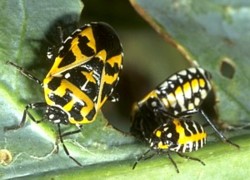 Harlequin
Bug: Adult & Nymphs (R. Bessin, 2000)
Harlequin
Bug: Adult & Nymphs (R. Bessin, 2000) |
|
|
|
GREEN
STINK BUGS
GENUS
and SPECIES: Acrosternum hilare (green stink bug), Nezara
viridula (Southern Green Stink Bug)
The
Green Stink Bug, Acrosternum hilare, and
the Southern Green Stink Bug, Nezara viridula,
are pests on a variety of plants, including corn, soybean, and cotton,
plus orchard plants like cherry trees and orange trees. These
stink bugs are both found in Kentucky, but are more important pests
further south in the United States. The two species are virtually
identical in color, shape, and size (about 18 mm full-grown). |
| |
 Green
Stink Bug (R. Bessin, 2000)
Green
Stink Bug (R. Bessin, 2000) |
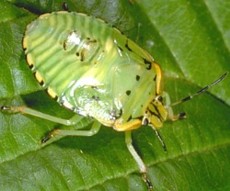 Green
Stink Bug Nymph (R. Bessin, 2000)
Green
Stink Bug Nymph (R. Bessin, 2000) |
|
|
|
SPINED
SOLDIER BUG
GENUS:
Podisus maculiventris
The
predatory Spined Soldier Bug, Podisus maculiventris,
pictured below, is a beneficial insect that feeds on insect pests.
It is common in field crops, gardens, and in weedy areas where
it feeds on caterpillars and other slow-moving arthropods. The
spined soldier bug is pictured feeding in the Ecology
section above. The spined soldier bug nymph is also pictured
above. The spined soldier bug is about
1 cm long, full-grown. |
| |
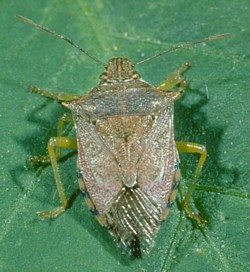 Spined
Soldier Bug (R. Bessin, 2000)
Spined
Soldier Bug (R. Bessin, 2000) |
|
|
|
TWO-SPOTTED
STINK BUG
GENUS
and SPECIES: Perillus bioculatus
The
red and black Two-Spotted Stink Bug, Perillus
bioculatus, below, is a predatory stink bug associated with crops
and gardens. It is usually about 8mm long. |
| |
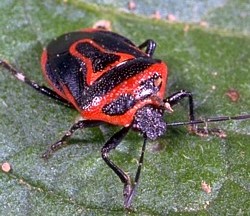 Two-Spotted
Stink Bug (R. Bessin, 2000)
Two-Spotted
Stink Bug (R. Bessin, 2000) |
|
|
|
ROUGH
STINK BUGS
GENUS:
Brochymena
Kentucky
is home to several Rough Stink Bugs (also sometimes called "arboreal stink bugs" or "tree stink bugs"), like those
pictured below. These stink bugs belong to the Brochymena genus. Commonly-encountered species have
rough, dark-brown bodies, and this coloration may provide camouflage on tree bark.
These species are usually fairy large, with body lengths of up to
15mm.
These stink bugs are often referred to (including, previously on this page!) as predators, although this may not be true. Work by Jay McPherson from Southern Illinois University shows that common Brochymena species are primarily herbivorous, although occasional predation may occur. |
| |
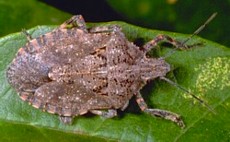 Rough
Stink Bug (R. Bessin, 2000)
Rough
Stink Bug (R. Bessin, 2000) |
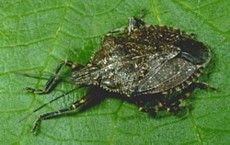 Rough
Stink Bug (R. Bessin, 2000)
Rough
Stink Bug (R. Bessin, 2000) |
|
|
|
RED-SHOULDERED
STINK BUGS
GENUS:
Thyanta
Red-Shouldered
Stink Bugs, like the one pictured below, are members of the
genus Thyanta. They are herbivorous and are found in
a variety of weedy habitats. They are about 1 cm long. |
| |
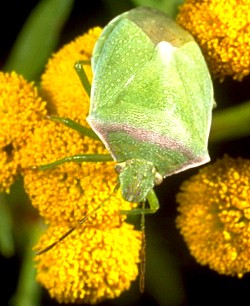 Red-Shouldered
Stink Bug (R. Bessin, 2000)
Red-Shouldered
Stink Bug (R. Bessin, 2000) |
|
|
|
MORMIDEA
spp.
GENUS:
Mormidea
Pictured
below is a small (5 mm) stink bug from the genus Mormidea.
These stink bugs are common in weeds and other low-growing vegetation. |
| |
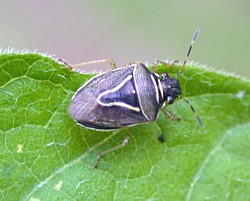
Mormidea
Stink Bug (B. Newton, 2002) |
|
|
|
RICE
STINK BUG
GENUS
& SPECIES: Oebalus pugnax
The Rice Stink Bug,
Oebalus pugnax,
is an important pest in
southern states like Louisiana where much rice is grown. In
Kentucky, this insect feeds on grasses. It is about 3/8"
long. Thanks to Steve Hahus, a high-school teacher in Owensboro,
KY, for allowing us to use this image! |
| |

Rice
Stink Bug (S. Hahus, 2005) |
|
| |
| COLLECTING
& PHOTOGRAPHY |
|
There are many species
of stink bugs to collect, and some are as colorful as beetles, so
they are always a nice addition to an insect collection. Look
for stink bugs on warm days in gardens, crops, weeds, trees, and
just about any other kinds of vegetation. They are normally
slow moving and do not fly readily, so they are easy to capture
and will usually remain still for a photograph. Be careful:
some of the predatory species can give a painful (but harmless)
bite if handled.
Predatory stink bugs
can also be kept as pets, and usually do well in captivity, although
most species only live for a year or two. Pet stink bugs can
normally be cared for in the same way as pet
assassin bugs.
|
| |
| STINK
BUG FACTS |
|
Because some stink
bugs are good predators, scientists are interested in using them
as natural control agents of crop pests. Read about the importance
of the spined soldier bug in Wisconsin:
http://www.entomology.wisc.edu/mbcn/kyf208.html
|
| |
| MYTHS
- LEGENDS - FOLKLORE |
|
Stink bugs have a reputation
for being "smelly." Although it is true that stink
bugs release an odor when disturbed or when crushed, many other
insects have this same characteristic, including most other true
bugs, ants, and many beetles (e.g. ladybugs). |
| |
Original document: 25 May 2004
Last updated: 9 July 2010
Photos courtesy R. Bessin and B. Newton, University of Kentucky
The Kentucky Critter
Files are maintained by Blake Newton, Department of Entomology, University
of Kentucky.
Contact: blaken@uky.edu
|
|

